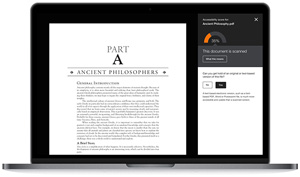Making Progress on Course Content Accessibility
May 23, 2018
Although most universities have just about mastered website accessibility, their efforts to make sure all course content can be accessed and used by students with disabilities have proved more challenging. "We have been fighting this uphill battle of content accessibility for years, and we have been fighting it without knowing what is actually out there," said Jeremy Olguin, accessible technology manager at California State University, Chico. "If you can't inventory, you can't manage."
But new tools are providing more transparency into classroom document accessibility and automating some steps in making more accessible alternatives available. For the past year, Chico State has been piloting Blackboard Ally, a program that automatically runs all course materials through a checklist of common accessibility issues. Ally, which works with several learning management systems, then generates a range of more accessible alternatives for the instructor's original and will make these available to all students in the course. These alternative accessible formats include Semantic HTML, audio, ePub and electronic braille. "The faculty members love that, because they don't have to take an extra step," Olquin said.
The deployment gives the Office of Accessible Technology and Services a campuswide view of accessibility issues. "We can look at departments or drill down to the class or the faculty member who may need help," Olquin said.

There are still times when Ally can't fix the problem with a document or when a course involves video content, so Chico has set up a support structure to help faculty members. "We assign instructors to a student assistant in our office who is their point of contact for anything they need," Olquin said. "We enter a support ticket for open communication and we will inventory your whole class for you. We tell them: 'These seven items need further attention that your student assistant will work on, and these 15 items, which are mostly tagging images and giving them descriptions, we would like you to do and we will show you how to do that.' That model has really worked well for us."
Olquin said the Ally pilot has involved 50 faculty members and 150 classes so far and is now ready to expand to the rest of campus. "We are already scaling it really well," he said. "We will ramp up to 200 classes and see how we do. Everything is on schedule for full release for fall 2018." CSU has purchased a systemwide site license for Ally, so all 23 campuses will be rolling it out over the next several years. Chico and Cal State East Bay were the first two to go live.
Chico State also worked with software company Kaltura to inventory all video course content and set up a workflow to caption all of it. First, the video is sent into the Kaltura cloud, where it is auto-captioned using integrated transcription service cielo24. Then it goes to captioners at CSU who fix up those auto-captions and push it right back into the LMS. "The faculty member would never know that it left their course," Olquin said. "It all happens on the back end."
Making Student-Created Content Accessible
While many campuses are making progress with the accessibility of instructor-created content, Wichita State University (KS) is going a step further by tackling student-created content too.
Source: Campus Technology

